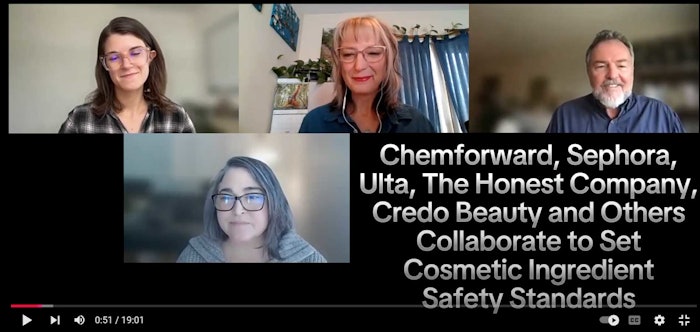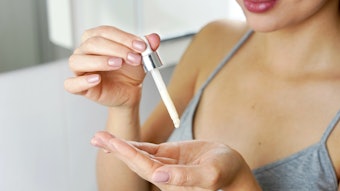
How well do we know our beauty ingredients? According to a new report from Chemforward, Sephora, Ulta, The Honest Company and Credo Beauty, there may still be some work to do. Chemforward and its brand and retail partners have built reports for each that assess how complete the safety data is for given cosmetic ingredients—and to determine where there are data gaps. The goal is to equip product developers with as much hazard data as possible to help them choose the safest ingredients for the task at hand or identify potential ingredients of concern. Now, through its Know Better, Do Better (KBDB) Collaborative, in partnership with these partners, including suppliers like Inolex and Dow, Chemforward has released findings aggregating these reports to set clear standards for cosmetic ingredient safety.
Log in to view the full article
How well do we know our beauty ingredients? According to a new report from Chemforward, Sephora, Ulta, The Honest Company and Credo Beauty, there may still be some work to do. Chemforward and its brand and retail partners have built reports for each that assess how complete the safety data is for given cosmetic ingredients—and to determine where there are data gaps. The goal is to equip product developers with as much hazard data as possible to help them choose the safest ingredients for the task at hand or identify potential ingredients of concern. Now, through its Know Better, Do Better (KBDB) Collaborative, in partnership with these partners, including suppliers like Inolex and Dow, Chemforward has released findings aggregating these reports to set clear standards for cosmetic ingredient safety.
The Beauty & Personal Care Ingredient Intelligence Report analyzed some 8,500 products with nearly 318,000 ingredients, rating materials from A (low level, high risk) through F (high hazard, high risk in most scenarios) in terms of their potential risk based on the available safety data available. Per the source, a comprehensive hazard assessment covers more than 21 human and environmental endpoints and applicable routes of exposure, and includes classification rationales for each endpoint.
The report identified:
- 70% of beauty ingredients are well-characterized for safety but
- 30% require urgent action to ensure safety.
Also, 10 chemicals of concern that occur frequently but are considered emerging chemical classes of concern (Ds and Fs) were identified. These include:
- Cyclopentasiloxane
- HT (Butylated hydroxytoluene)
- Chromium oxide greens (CI 77288)
- Methylparaben
- Carbomer (chlorinated)
- Red 30 (CI 73360)
- Red 27 (CI 45410)
- Butylphenyl methylpropional (Lilial)
- Ehtylhexyl methoxycinnamate (octonixate)
- Aluminum powder (CI 77000)
Per the source, this highlights significant progress by the industry but also the need to characterize the remaining 30% chemicals for human and environmental impacts.
Stacy Glass, co-founder and executive director of Chemforward, explained how the report came together. "...[O]ver the course of a bout of years, we were running individual ingredient intelligence reports for each of these companies...so what we're doing [now] is bringing that all together and making [the 2023 data from this group] public." She added that, through these reports, the companies and Chemforward see that the beauty industry is using safer chemistry but there are some high hazards that need to be addressed. "Thirty percent of the ingredients being used are unknown in terms of what the human and environmental impacts are. I think that was the rallying point [for this report]."
A Roadmap to Beauty Brand Success
With tightening global regulations on chemical safety and growing consumer scrutiny, brands that fail to prioritize safer chemistry risk being left behind, Chemforward reports. Those embracing transparency and reformulation will be best positioned to thrive in an increasingly competitive, informed market. This report is therefore a critical roadmap for beauty brands to transition from harmful chemicals toward sustainable, long-term success.
Getting Ahead of Cosmetic Regulations
"Chemforward's mission is to create broad access to chemical hazard data and specifically illuminate safer alternatives," explained Glass, who added that the market driver was, "this idea of getting ahead of regulation or just [the thought of] what's the next chemical that's going to come on to everybody's radar, whether it be a consumer concern or a regulatory concern. When we engage in proactive chemical assessment, then we understand what's sort of in the 'low' concern and what's in the 'high' concern zone."
Heather McKenney, science and safer chemistry lead at Chemforward, noted, "Most of these chemicals that we see used in beauty and personal care products have some level of information available. They might be on a list somewhere but then the quality and the credibility of that list, of course, is something that we need to understand....[W]hat hasn't happened with that data, [in order to deem a material as low risk], is it hasn't been packaged into useful hazard information, which can then inform individual endpoints of concern. So, just because there's data out there that says, you know in an RIPT panel, there was sensitization, that doesn't tell us if this is a high-hazard skin sensitizer. Really we need the experts to go through that data and provide a classification under existing chemical hazard assessment methodologies."
She continued, "What's really important for us is that there is criteria to test out of that D hazard band, [for example], because we are a data-driven organization. If there were data available for a chlorinated organic substance, for example, to fill some of those data gaps and show that some of those key hazard traits are actually of low hazard, one of those chemicals could then be elevated into an A, B or C hazard band as long as the data did exist."
Setting Chemistry Safety Benchmarks
The report aims to set a new benchmark for consumer health and environmental sustainability in the $100 billion personal care market as well as other sectors.
“This report shows that beauty and safety can, and must, go hand in hand,” said Stacy Glass, co-founder and executive director of Chemforward. “With the power of shared data and collaboration, the beauty industry is on the cusp of a transformation that prioritizes human health and environmental responsibility.”
"Using safer ingredients isn’t just about doing the right thing — it’s a must for the cosmetics industry,” said Christina Ross, director of science and policy at Credo Beauty. “Real change starts with getting the science right — and rigorous hazard assessments and ingredient transparency are essential baseline scientific practices to drive our industry forward. By prioritizing safer ingredients and committing to higher standards, we can collectively drive innovation, build trust and set a new norm.”
Bill Walsh, director of the Safe Chemistry Impact Fund, which in part helped to fund this initiative, noted, "Beauty and personal care is on the forefront of something that's really a trend across industries."
McKenney added, "I'm really excited to see how this work can be used cross-sectionally — across beauty, personal care, electronics ... this information can really help support additional sectors."
Hear more from our exclusive interview:










